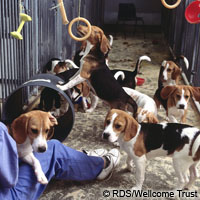New coalition campaigns for animal testing for biomedical research
A group of European scientists have come together to form the European Coalition for Biomedical Research (ECBR) with the intention of influencing the revision of Directive 86/609 on the protection of animals used for scientific research. According to the European Commission, 'In recent years, it has become increasingly apparent that the Directive needs to be revised in order to promote improvements in the welfare of laboratory animals and to further foster the development of alternative methods.' The Directive, adopted in 1986, was designed to improve controls on the use of laboratory animals, set minimum standards for housing and care, as well as the training of personnel involved with laboratory animals. The Directive also aimed to reduce the number of animals used for experiments, and was the basis for the establishment of the European Centre for the Validation of Alternative Methods (ECVAM). However, the Commission believes that a number of the Directive's provisions are open to interpretation, and that the style of some provisions is more political than regulatory in nature. There is also no mention of ethical review processes, compulsory authorisation of experiments or the 3Rs - Reduction, Refinement and Replacement. In addition, new techniques such as the use of transgenic animals and cloning have been developed since the Directive was implemented. For this reason, the Commission has requested a preliminary impact assessment on the different options for revising the Directive. A public stakeholder consultation also took place during the summer of 2006. The results of both surveys are being used in the preparation of a new Commission proposal that is set to be published early in 2007. The newly formed ECBR believes that some of the revisions will hinder scientific research. 'Whilst there is much that is sensible, there are also some rather dangerous suggestions,' says Mark Matfield, Director of the European Biomedical Research Association and Secretary General of the ECBR. Dr Matfield gives the example of a proposal to limit the use of non-human primates in research to those that have been bred for two or more generations in captivity. 'There aren't enough of these two-generation captive bred laboratory primates, and it would take years for sufficient numbers to become available,' he says. While the use of primates for scientific experiments is distasteful to many, Dr Matfield claims that they are essential for areas of neuroscience and virology research, biotechnology development, the development of vaccines for AIDS and malaria and the testing of new treatments for cancer and multiple sclerosis. A 2005 statistical report by the European Commission reported that 10.7 million animals were used in 2002 in experiments (figures from France referred to 2001). Of these, 0.1% were primates, making the number around 10,700. The new coalition brings together 34 societies and associations representing some 37,000 academics. 'We think that having such a broad coalition, both in geographical terms and as far as different scientific disciplines are concerned, should be of great help in ensuring that these messages are promulgated effectively and to the right audiences and that the voice of the European scientific community will be heard loud and clear,' says Peter Janssen from the Belgian Society of Neuroscience, member of the ECBR's Executive Group.



